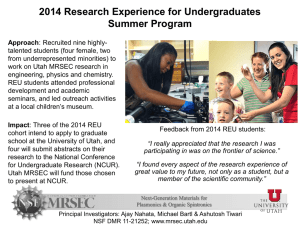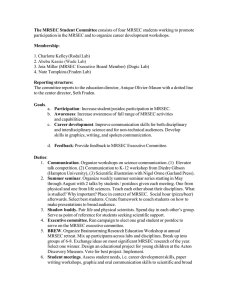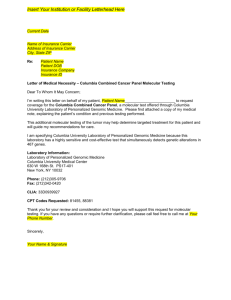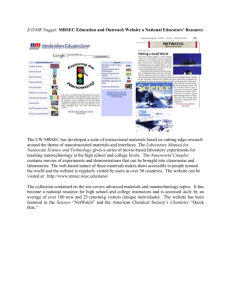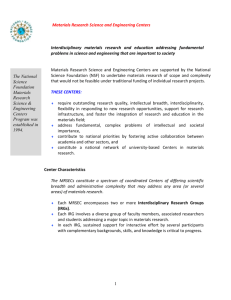Columbia University - Materials Research Science and Engineering
advertisement
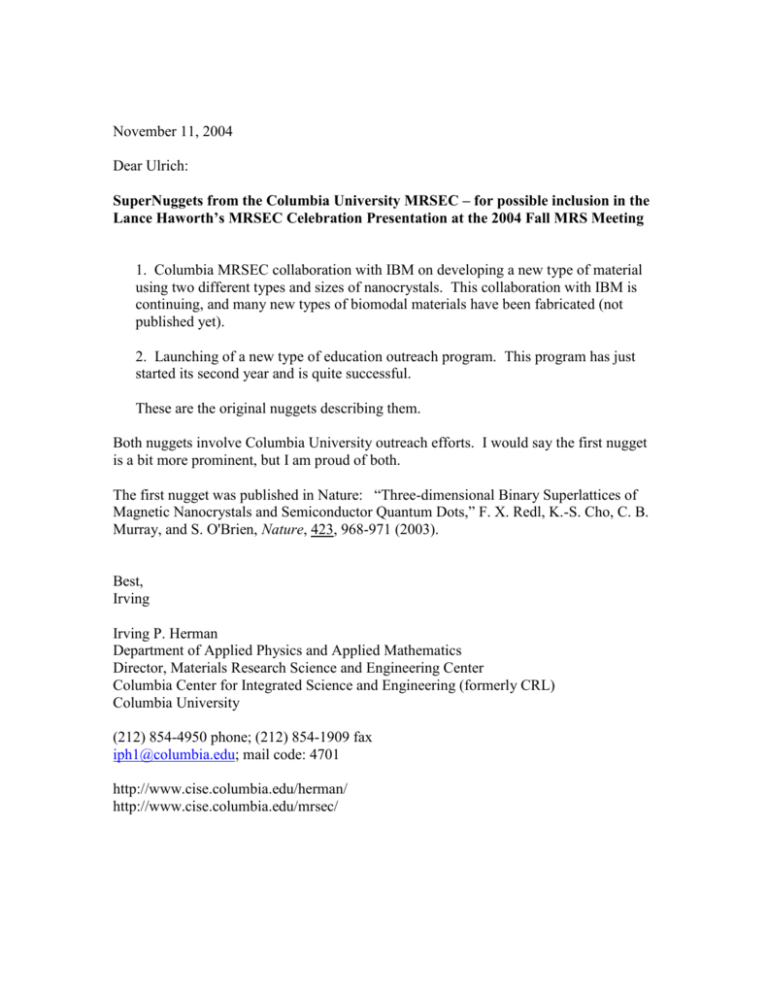
November 11, 2004 Dear Ulrich: SuperNuggets from the Columbia University MRSEC – for possible inclusion in the Lance Haworth’s MRSEC Celebration Presentation at the 2004 Fall MRS Meeting 1. Columbia MRSEC collaboration with IBM on developing a new type of material using two different types and sizes of nanocrystals. This collaboration with IBM is continuing, and many new types of biomodal materials have been fabricated (not published yet). 2. Launching of a new type of education outreach program. This program has just started its second year and is quite successful. These are the original nuggets describing them. Both nuggets involve Columbia University outreach efforts. I would say the first nugget is a bit more prominent, but I am proud of both. The first nugget was published in Nature: “Three-dimensional Binary Superlattices of Magnetic Nanocrystals and Semiconductor Quantum Dots,” F. X. Redl, K.-S. Cho, C. B. Murray, and S. O'Brien, Nature, 423, 968-971 (2003). Best, Irving Irving P. Herman Department of Applied Physics and Applied Mathematics Director, Materials Research Science and Engineering Center Columbia Center for Integrated Science and Engineering (formerly CRL) Columbia University (212) 854-4950 phone; (212) 854-1909 fax iph1@columbia.edu; mail code: 4701 http://www.cise.columbia.edu/herman/ http://www.cise.columbia.edu/mrsec/ Columbia University MRSEC 2003 Science/Research Nugget: For more information, please contact Stephen O'Brien. First 3-D Assembly of Magnetic and Semiconducting Nanoparticles One challenge in preparing new nanomaterials is fabricating three-dimensional designer materials assembled from two different types of nanoparticles. Professor Stephen O'Brien, in collaboration with Dr. Chris Murray of the IBM T. J. Watson Research Center, MRSEC/IBM bridging postdoctoral scientist Dr. Franz Redl, and coworkers at the University of New Orleans have done precisely that by tailoring the experimental conditions so that nanoparticles with dissimilar, yet complementary properties would assemble themselves into repeating 3-D patterns. One type is composed of lead selenide, a semiconductor that has applications in infrared detectors and thermal imaging and can be tuned to be more sensitive to specific infrared wavelengths. The other material, magnetic iron oxide, is best known for its use in the coatings for certain magnetic recording media. This combination of these nanoparticles may have novel magneto-optical properties as well as properties key to the realization of quantum computing. For example, it might be possible to modulate the material's optical properties by applying an external magnetic field. To produce an ordered structure, such as that shown in the accompanying transmission electron micrograph (TEM), the particles had to be very uniform, all within 5 percent of the target size. The iron oxide particles were 11 nanometers in diameter, and contained approximately 60,000 atoms, and the lead selenide particles 6 nanometers were in diameter, and contained approximately 3,000 atoms. Forming these so-called "crystal structures," as opposed to random mixtures of nanoparticles, is essential for the composite material to exhibit consistent, predictable behavior. Such new materials with otherwise unattainable properties, are sometimes referred to as "metamaterials." Tranmission electron micrograph of the iron oxide/lead selenide nanoparticle bimodal 3D superlattice. Columbia University MRSEC 2003 Broader Impacts-Education Nugget For more information, please contact Irving Herman. New Columbia MRSEC Education Partnership with New York City Secondary Schools to Enhance the Curriculum is Launched: The McNair CITIES Program On Wednesday, September 3, 2003, Professor Irving Herman and Ms. Alison Biuso visited the George Washington High School campus in NYC to launch a new Columbia MRSEC education outreach program to help motivate and engage students by integrating materials science and engineering demonstrations into the curriculum. Columbia chemistry graduate students Ms. Jing Tang and Mr. Matt Sfeir presented the demonstrations used in the MRSEC High School Visitation Program (see accompanying photograph) to an audience of 35 New York City high school and middle school science teachers (from the northern Manhattan, Instructional Region 10). This audience also included Mr. Carl Raab - advisor to the NYC Department of Education and the Columbia MRSEC, and Ms. Julie Torres, Assistant Principal for Science at High School for Media and Communications (at the GWHS campus), who, along with Local Instructional Superintendent of Region 10 Mr. Larry Block, will work with the MRSEC to develop and implement this program. The goal is for the MRSEC and NYC to adapt, modify, and develop materials science demonstrations and to incorporate them into current New York City high school and middle school chemistry, physics and earth science classes. We want to help teachers teach to the NYC standards in these subjects even more effectively by improving student engagement. This will be a fully interactive effort between MRSEC faculty, students and postdoctoral scientists, and NYC science teachers. It has been named the “Ron McNair Curriculum Integration To Interactively Engage Students (CITIES) Program”. Ms. Jing Tang explaining the phase transition of a shape memory alloy at the launching of the Columbia MRSEC/NYC Partnership to enhance the curriculum.
